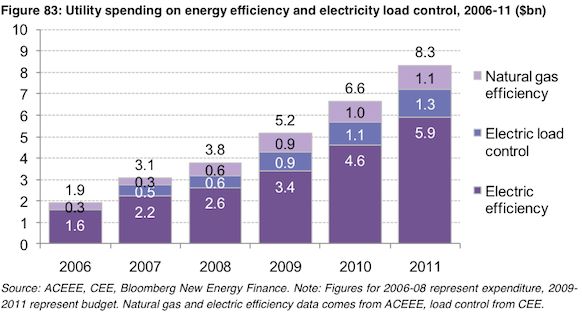Energy efficiency is an enigma in the U.S. -- so simple, yet so difficult. For those in the industry, it can feel as if forward movement is as slow as molasses. But there is progress, according to a recent report from Bloomberg New Energy Finance and the Business Council for Sustainable Energy.
Commercial buildings have seen a drop in their energy intensity of more than 40 percent since 1980, according to the report. The cut in energy use can be attributed to increased utility energy efficiency programs and increased standards.

U.S. utilities spent about $7 billion in 2011 on energy efficiency, not including demand response, up from about $2 billion in 2006. The increased spend is due to decoupling utility’s revenue from the amount of kilowatt-hours sold in many states, energy efficiency resource standards and increased building and appliance standards.
Utilities’ energy efficiency program spending is only meant to increase in coming years, and even more states could move toward decoupling. Appliance and building standards, however, continue to be the real winner. Many states are also requiring large commercial buildings to disclose energy use, which will help drive efficiency further by bringing energy use to the forefront of building owners’ minds.

One important caveat is that while primary energy is significantly lowered, overall electricity use is relatively flat. While standards have reduced the energy use of lighting and appliances, that electricity demand tends to be replaced by more stuff -- more plugged-in iPads, smartphones and laptops.
For all of the gains in the past decade, there is far more that can be accomplished. The retrofit market is ripe for innovative financing options, which is starting to happen with new utility on-bill financing and property-assessed clean energy programs.
Standards are also more important than ever. Not only do existing standards need to be continuously improved -- for both commercial and residential appliances -- but it is also important to impose standards on all that new stuff streaming into our lives and taking up plug space, whether those plugs are on a factory floor or in our living rooms. Increasingly, it may take systems-level thinking, rather than individual standards, to get to the next level of efficiency.



